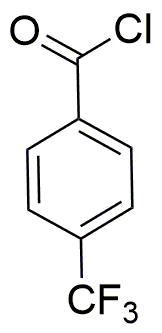4-(Trifluoromethyl)benzoyl chloride is widely utilized in research focused on:
- Pharmaceutical Synthesis: This compound serves as a key intermediate in the production of various pharmaceuticals, particularly those requiring trifluoromethyl groups, which enhance biological activity and metabolic stability.
- Agricultural Chemicals: It is used in the formulation of agrochemicals, including herbicides and pesticides, where the trifluoromethyl group contributes to improved efficacy and selectivity against pests.
- Material Science: The compound is involved in the development of advanced materials, such as polymers and coatings, that benefit from its unique chemical properties, leading to enhanced durability and resistance to environmental factors.
- Organic Synthesis: As a versatile reagent, it facilitates various organic transformations, making it valuable for chemists looking to create complex molecules efficiently.
- Fluorinated Compounds: It plays a significant role in the synthesis of fluorinated compounds, which are important in numerous applications, including specialty chemicals and surfactants, due to their unique properties.
General Information
Properties
Safety and Regulations
Applications
4-(Trifluoromethyl)benzoyl chloride is widely utilized in research focused on:
- Pharmaceutical Synthesis: This compound serves as a key intermediate in the production of various pharmaceuticals, particularly those requiring trifluoromethyl groups, which enhance biological activity and metabolic stability.
- Agricultural Chemicals: It is used in the formulation of agrochemicals, including herbicides and pesticides, where the trifluoromethyl group contributes to improved efficacy and selectivity against pests.
- Material Science: The compound is involved in the development of advanced materials, such as polymers and coatings, that benefit from its unique chemical properties, leading to enhanced durability and resistance to environmental factors.
- Organic Synthesis: As a versatile reagent, it facilitates various organic transformations, making it valuable for chemists looking to create complex molecules efficiently.
- Fluorinated Compounds: It plays a significant role in the synthesis of fluorinated compounds, which are important in numerous applications, including specialty chemicals and surfactants, due to their unique properties.
Documents
Safety Data Sheets (SDS)
The SDS provides comprehensive safety information on handling, storage, and disposal of the product.
Product Specification (PS)
The PS provides a comprehensive breakdown of the product’s properties, including chemical composition, physical state, purity, and storage requirements. It also details acceptable quality ranges and the product's intended applications.
Certificates of Analysis (COA)
Search for Certificates of Analysis (COA) by entering the products Lot Number. Lot and Batch Numbers can be found on a product’s label following the words ‘Lot’ or ‘Batch’.
Numéro de catalogue
Numéro de lot/série
Certificates Of Origin (COO)
This COO confirms the country where the product was manufactured, and also details the materials and components used in it and whether it is derived from natural, synthetic, or other specific sources. This certificate may be required for customs, trade, and regulatory compliance.
Numéro de catalogue
Numéro de lot/série
Safety Data Sheets (SDS)
The SDS provides comprehensive safety information on handling, storage, and disposal of the product.
DownloadProduct Specification (PS)
The PS provides a comprehensive breakdown of the product’s properties, including chemical composition, physical state, purity, and storage requirements. It also details acceptable quality ranges and the product's intended applications.
DownloadCertificates of Analysis (COA)
Search for Certificates of Analysis (COA) by entering the products Lot Number. Lot and Batch Numbers can be found on a product’s label following the words ‘Lot’ or ‘Batch’.
Numéro de catalogue
Numéro de lot/série
Certificates Of Origin (COO)
This COO confirms the country where the product was manufactured, and also details the materials and components used in it and whether it is derived from natural, synthetic, or other specific sources. This certificate may be required for customs, trade, and regulatory compliance.


